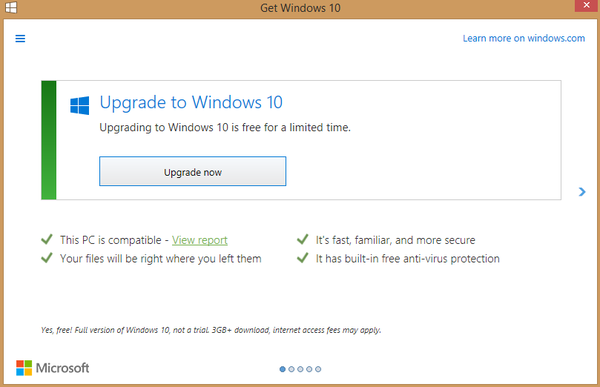Windows 10 is a recommended update now
Microsoft changed the state of the "upgrade to Windows 10" update for Windows 7 and 8.1 devices to recommended on February 1, 2016 from optional.
Microsoft continues to push Windows 10, and as the company announced back in October 2015, made the upgrade to its latest operating system Windows 10 a recommended update on devices running Windows 7 or Windows 8.1.
The main difference between optional and recommended updates is that recommended updates may be installed automatically on devices running Windows depending on how the system is configured.
On some devices, on those where the option to handle recommended updates similar to important updates is enabled, the upgrade may be downloaded without further consent on the user's part (there is still a prompt though to initiate the upgrade process).
Microsoft notes however that most Windows 7 and 8.1 users will be able to decline the upgrade offer to Windows 10 in case they don't want to upgrade their computer systems to the new operating system.

Basically, Windows users may get the offer to Windows 10 if they have enabled automatic updates on their device. Windows may even download part of the update in advance prior to the user's acceptance of the download.
The reason behind the move, according to Microsoft, is to make it easier for customers to schedule a time for their upgrade to take place.
It is likely however that the change is going to irritate some customers who don't want to upgrade their systems to the newest version, something that at least some state is more difficult than getting the upgrade to install on machines.
It is likely that some users who use systems operated by Windows 7 or Windows 8.1 will be caught off-guard by the change even though it has been announced in advanced and been reported by major tech sites and other sites as well.
Windows systems that are configured either via Group Policy or the Registry to block the upgrade from being installed in first place won't be affected by the change. The option is best for users who don't want their machines to be upgrade.
Software like GWX Control Panel may also help in preventing the installation of the upgrade, even though it has become quite difficult to block it permanently.
Windows users who want to check up on their machines update settings may do so in the following way:
- Tap on the Windows-key, type Windows Update and hit enter.
- In the left pane, click on the "change settings" link.
- Under "important updates", select an appropriate option for the handling of updates (check for updates but let me choose whether to download and install them).
- Under recommended updates, make sure the box "give me recommended updates the same way I received important updates" is not checked.
If Windows 8 is the operating system that is used, you may need to click on "advanced options" first before the selection becomes available.
This article was first seen on ComTek's "TekBits" Technology News

- Log in to post comments